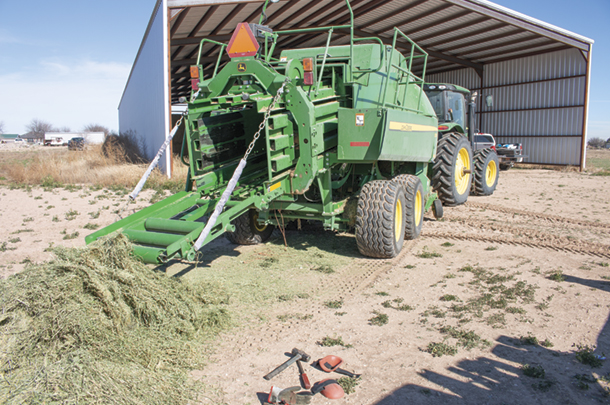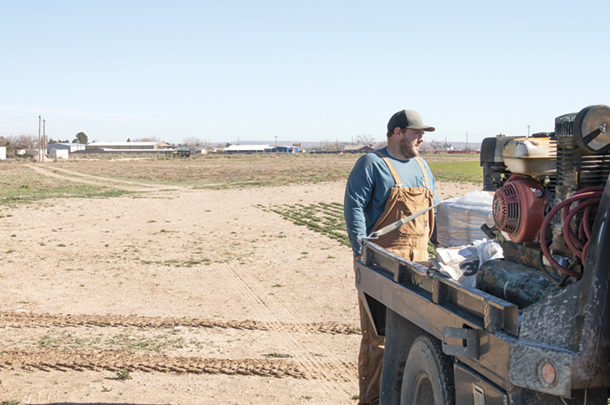Jackson grew up watching his grandfather run a production alfalfa business while his father worked as a crop consultant. Working on the farm in southeastern New Mexico from a young age, he helped in any way he could. He always had a passion for helping out on the farm and recalls begging his parents to let him go work.
After finishing high school, he completed a degree in petroleum engineering and went to work in the oil field, where he learned to analyze things from different angles to find the most efficient solution. Now he applies that strategy to his production alfalfa business.
Jackson began to take over his family’s farm, as well as buying 160 acres on his own to grow the operation. In all, he manages around 600 acres that average six cuttings a year, all while still working as a consultant for oil field companies.
Alfalfa is the primary crop of his operation, opting to rotate triticale or wheat in when necessary. But those choices haven’t been made without trying his fair share of other options. Jackson says he has also grown teff grass and timothy grass to double crop with his wheat rotation.
“In the past, we’ve grown corn when rotating out of alfalfa,” says Jackson, “but the corn uses a lot of water, and we can make the water stretch by supplementing it into hay. If oil is black gold, water is liquid platinum in our area.”
Jackson focuses on producing high-quality hay for the equestrian market. On average, he makes $100 more per ton by selling the hay on the horse market than he would to a dairy.
“The dairy market has been hit hard lately,” Jackson says. “When I came back to the farm, we had to start looking at other options for a better return on investment.”
He works with local brokers to market his hay, implementing more modern technology to help bridge the gap and move his hay. He says in general producers are great at producing hay but bad at selling their own product.
He has even gone the extra step of posting hay for sale on Facebook or Hay Map, which he says created a lot of new relationships out of state that otherwise would have never formed.
Jackson is still cautious of to whom he will ship hay, stressing the importance of having an honest business relationship with his customers in order to avoid payment issues and making sure the customer is getting the quality of alfalfa they’ve requested.
Forage testing somewhat plays a role in his marketing strategy. The demand to have the product tested every load hasn’t risen enough to affect his ability to market untested hay; rather he relies more on pictures and videos of each of his cuttings of alfalfa by farm that are cataloged and sent to the customer before the hay is shipped.

The method Jackson uses to ship his product has also been boiled down to which is most efficient for his operation. He currently uses several 3X3 big balers to maximize the number of bales he can ship in a month. Two-string little bales were causing a bottleneck of trucks coming in and out and cutting down on the amount of hay he could load in a certain amount of time.
He also tried bundling two-string bales but found the bundles were too labor-intensive without enough return on investment to what he could accomplish with his big balers.
Labor in general is a challenge for Jackson; finding suitable workers who can get the job done while keeping his overhead costs low enough to turn a profit is his number one challenge going forward, he says. Currently, he relies on retirees who want to work fewer than 40 hours per week but are dependable and trustworthy.
The weather will also be a challenge for Jackson in the future. Getting moisture at the optimal time while hitting the perfect spot for humidity is crucial to producing a high-quality product that fits his marketing system, but he hopes a recent addition of a hay steamer can help fill that void. Significant amounts of rain while his hay is down could reduce the value of his product and leave him with hay that cannot be sold by his usual methods.
For now, Jackson says he will continue to tweak his formula to find the most efficient way to keep making consistent quality hay for his customers and continuing to be a steward to the land for generations to come. ![]()
PHOTO 1: Kale Jackson now produces hay on around 600 acres near Artesia, New Mexico.
PHOTO 2: Kale Jackson uses 3X3 balers to get the optimal amount of bales on each truck. Photos by Joy Hendrix.

-
Joy Hendrix
- Editor
- Progressive Forage
- Email Joy Hendrix












